Note this forecast page is not the most recent forecast available.
View the most current forecast report
Researcher Analyzes Arizona COVID-19 Spread Models for Decision-Makers
The following information regarding the spread of COVID-19 in Arizona was prepared by Joe Gerald, MD, PhD, a researcher at the Mel and Enid Zuckerman College of Public Health (MEZCOPH) at the University of Arizona. This information has also been reviewed by other MEZCOPH faculty.
This data were obtained from the Arizona Department of Health Services COVID-19 webpage and reflect conditions in Arizona as of December 17, 2021.
This information is intended to help guide our response to the outbreak. It is not intended to predict how this pandemic will evolve. Rather, this model extrapolates what might occur if current conditions remain unchanged. As regional authorities and healthcare providers respond, their actions are expected to mitigate the worst consequences of this pandemic.

COVID-19 Disease Outbreak Forecast
Arizona State and Pima County
Updated December 17, 2021
Disclaimer: This information represents my personal views and not those of The University of Arizona, the Zuckerman College of Public Health, or any other government entity. Any opinions, forecasts, or recommendations should be considered in conjunction with other corroborating and conflicting data. Updates can be accessed at https://publichealth.arizona.edu/news/2021/covid-19-forecast-model.
For the week ending December 12th, 24424 Arizonans were diagnosed with COVID-19, a 15% decrease from the 28746 cases initially reported last week (Figure 1). Unlike Thanksgiving week, this week’s decline in cases coincided with little reduction in testing and declining test positivity. When combined with declining hospital occupancy, it indicates transmission is at least temporarily slowing. Cases are currently being diagnosed at a rate of 336 cases per 100K residents per week. Rates are highest among those 25 – 64 years and lowest among those ≥65 years, 380 and 260 cases per 100K residents, respectively (Figure 2a below).
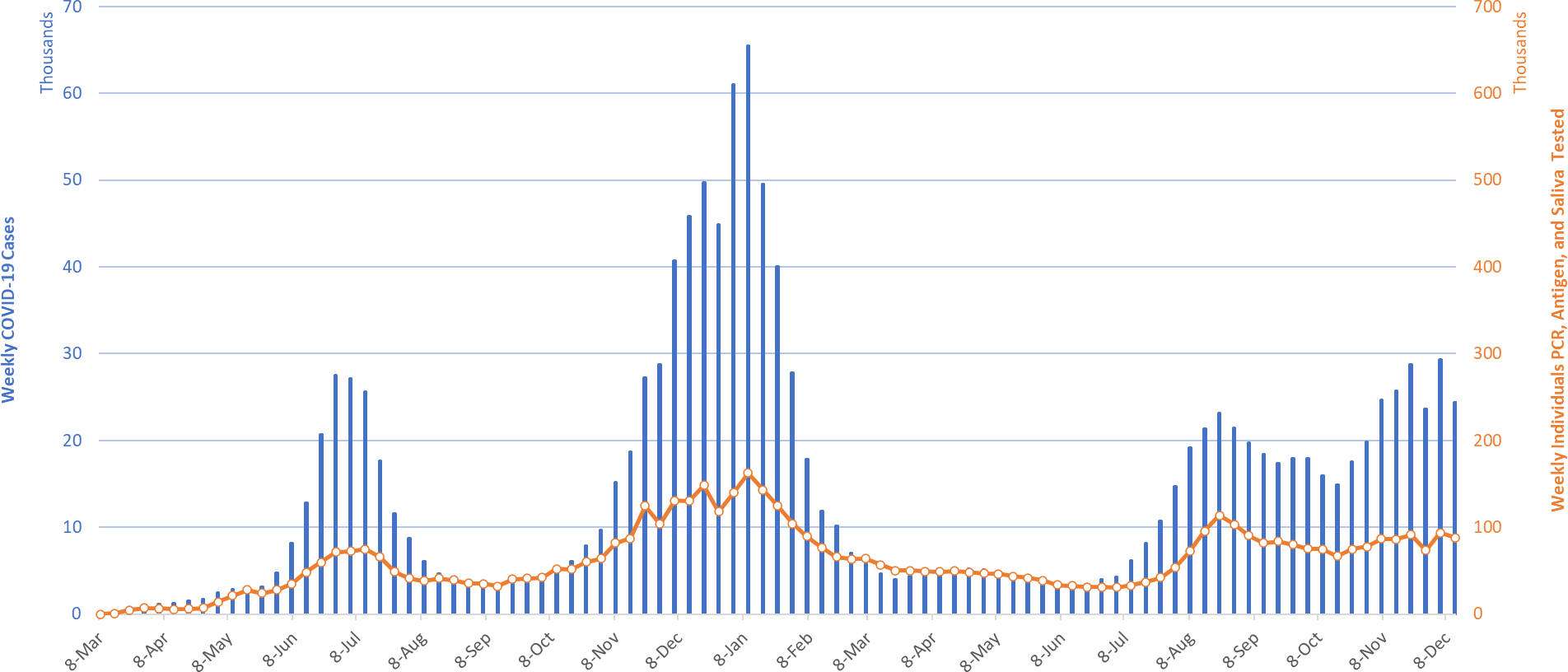
|
Figure 1. Weekly COVID-19 Cases in Arizona and Number of Individuals Undergoing COVID-19 Diagnostic Testing March 1, 2020 – December 12, 2021. |
Arizona’s new case ranking has dropped to 23rd. The nation’s current leaders are Rhode Island (720), New Hampshire (640), Maine (546), Wisconsin (541), and Connecticut (521). According to the CDC, only 28% of Arizona adults and 47% of its seniors are vaccinated with a third dose booster. The ADHS Vaccine Dashboard shows weekly doses delivered held steady at 200K doses. The CDC recommends everyone ≥18 years should receive a booster and has widened eligibility to those 16 – 17 years. With winter here, waning immunity among those without a booster will place them at risk of breakthrough infection from the circulating Omicron variant.
BROKEN RECORD → Arizona continues to experience a high number of cases, hospitalizations, and deaths. With waning vaccine efficacy and a potentially short duration of acquired immunity, herd immunity is not achievable. As time progresses, more individuals will become susceptible. While the previously vaccinated and previously infected will remain mostly protected from severe outcomes, they will contribute to community transmission. Unvaccinated Arizonans will not be able to avoid infection by “free riding” on high levels of community immunity. The decision to remain unvaccinated carries a much greater risk than getting vaccinated. For the vaccinated, third-shot boosters provide additional protection and should be a priority for anyone >50 years to ward off infection from the predominant Delta variant or the newly emergent Omicron variant.
Figure 2a shows transmission among all age groups, including children is declining (Figure 2b). Declines in children appear to have preceded reductions in adults by a week. As Christmas and New Year’s holidays brings major changes to work and social life, hospital COVID-19 occupancy will continue to provide a more consistent, although lagged, indicator of what is happening with viral transmission. Any reprieve prior to Omicron’s impact in mid-January is welcomed.
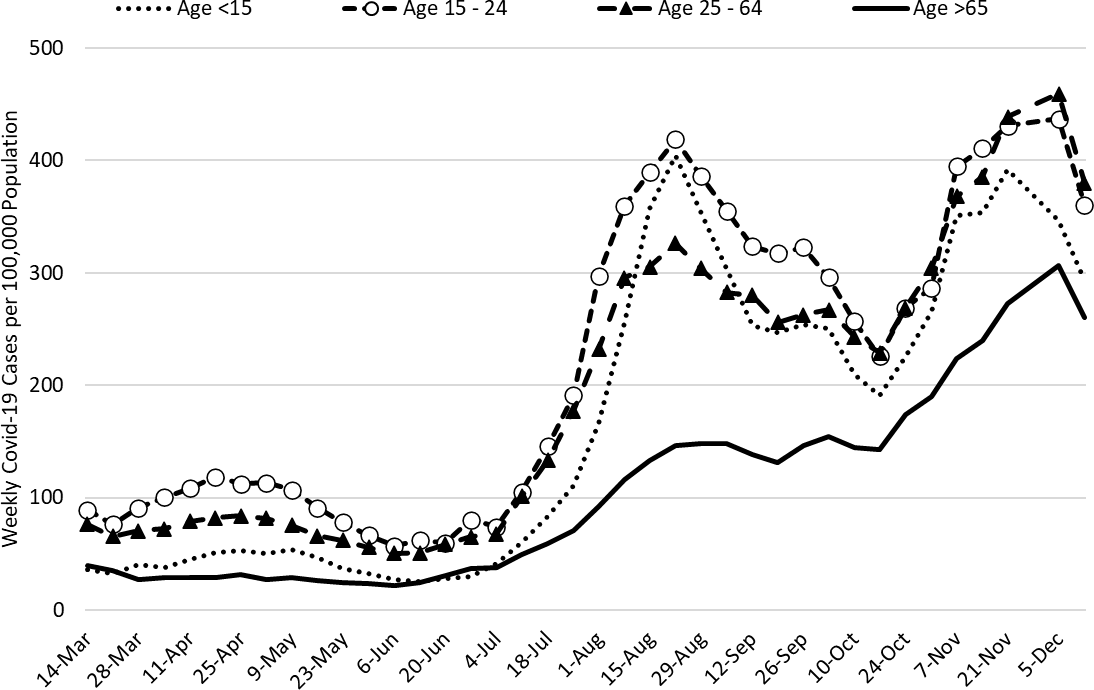
|
Figure 2a. COVID-19 Cases in Arizona by Age Group March 7 – December 12, 2021. (Data from week ending November 28 suppressed) |
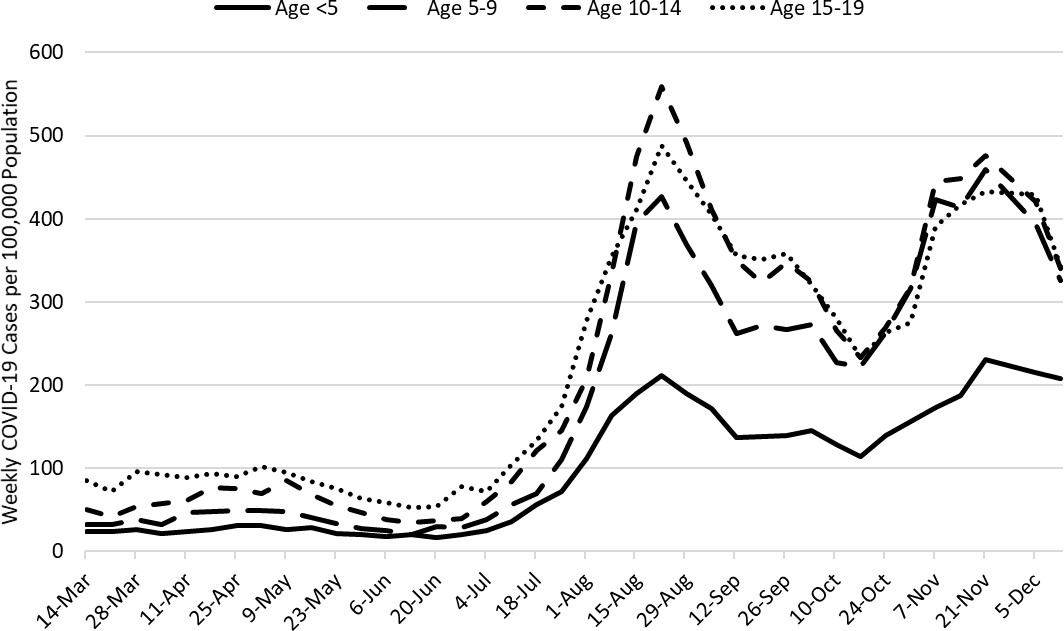
|
Figure 2b. COVID-19 Cases in Arizona among Children by Age Group March 7 – December 12, 2021. (Data from week ending November 28 suppressed) |
Over the past 2 weeks, test positivity had declined from 32% to 27%. Declining positivity on a slightly smaller testing base suggests that transmission is in fact waning. Testing remains inadequate for public health practice and many cases are going undiagnosed (Figure 3).
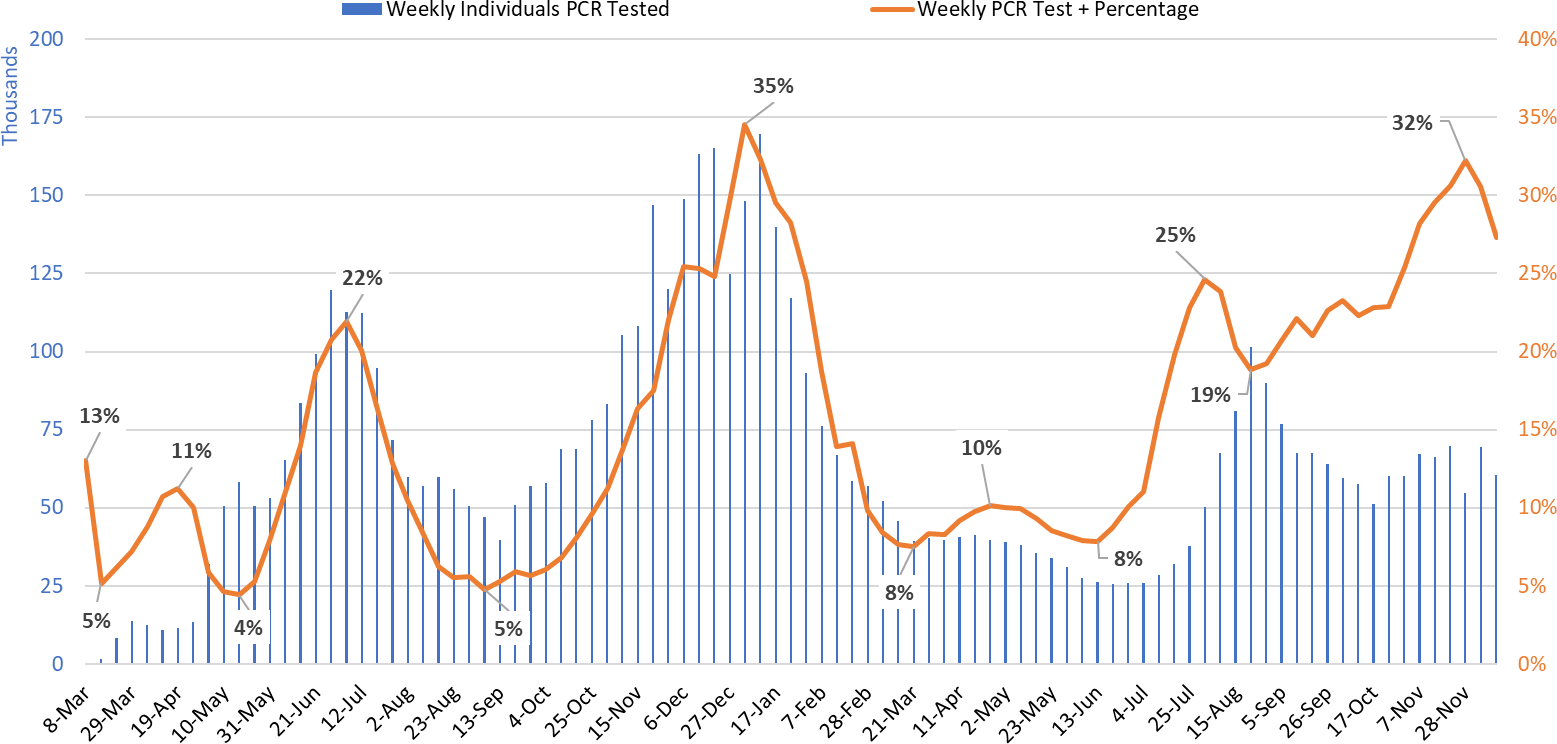
|
Figure 3. Weekly Number of Patients Undergoing Traditional Nasopharyngeal PCR Testing and Associated Percent Positivity March 1, 2020 – December 12, 2021. |
As of December 17th, 2533 (29%) of Arizona’s 8793 general ward beds were occupied by COVID-19 patients, an 8% decrease from last week’s 2749 occupied beds (Figure 4 and Figure 5 Panel A). Another 449 (5%) beds remained available for use which is higher last week’s record low of 392 available beds. Six-hundred eighty-two (682, 39%) of Arizona’s 1758 ICU beds were occupied by COVID-19 patients, a 5% decrease from last week’s 719 occupied beds (Figure 4 and Figure 5 Panel B). An additional 68 (4%) ICU beds remained available for use which is the same as last week’s record low of 78 beds. Peak occupancy occurred on December 8th at 3493 combined beds suggesting transmission peaked during the last week of November.
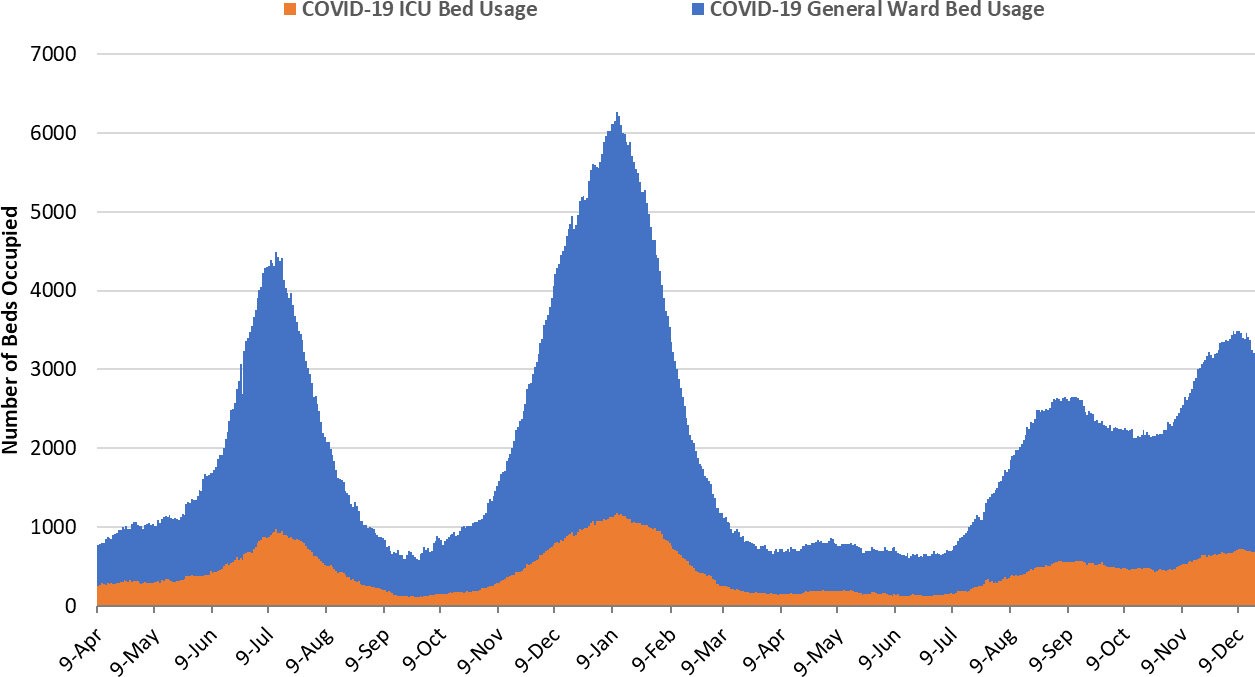
|
Figure 4. Arizona Daily COVID-19 General Ward and ICU Census April 9, 2020 – December 17, 2021. |
While peak occupancy will not reach prior levels, the base of the Delta wave is broader. The Delta wave has so far seen 127 days with a combined occupancy >2000 patients whereas the summer 2020 and winter 2021 waves saw 57 and 98 days, respectively. We have now had >3000 combined occupancy for 31 days whereas the summer 2020 and winter 2021 waves saw 35 and 78 days, respectively.
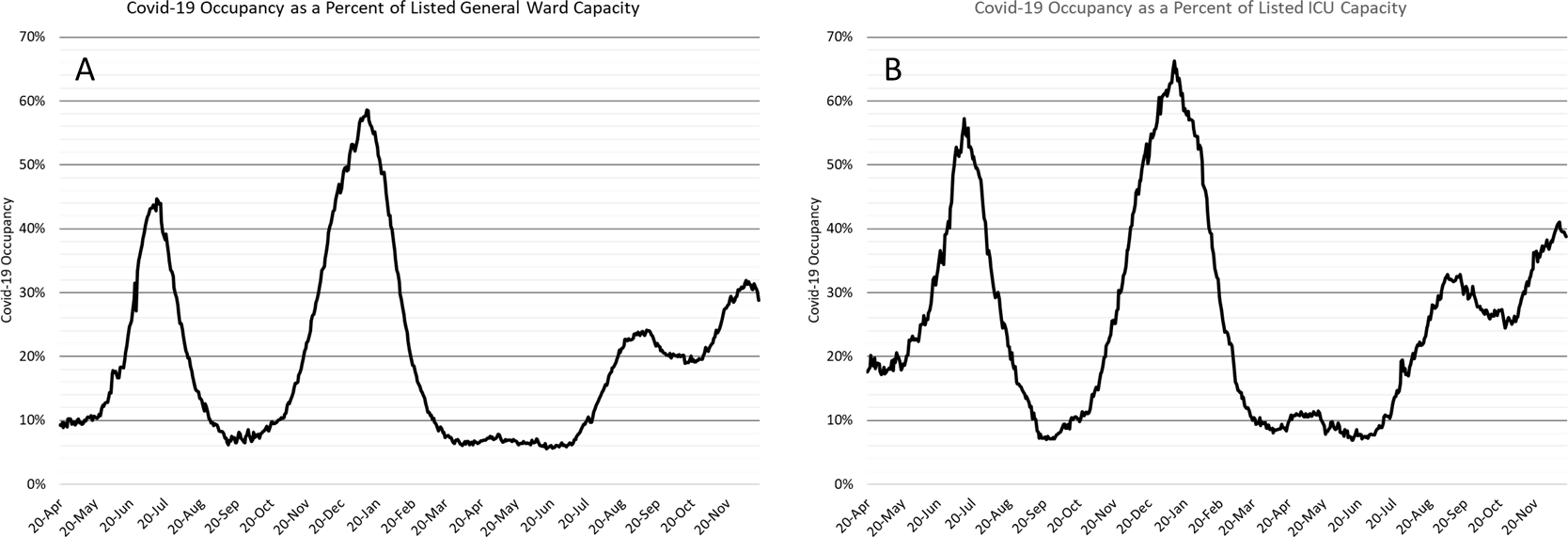
|
Figure 5. COVID-19 Occupancy as a Percent of Listed General Ward (A, left) and ICU (B, right) Capacity in Arizona April 20, 2020 – December 17, 2021. |
Hospital occupancy remains far above seasonal levels. Safety margins, as measured by available beds, remain at or just above historical lows (Figure 6). Hospitals should prepare for >25% ward occupancy and >35% ICU occupancy for some time. A new study of surgical volume indicates that after a sharp, but brief decline in early 2020, frequencies have since returned to pre-pandemic levels. Essentially, hospitals are doing everything these used to be doing plus COVID-19.
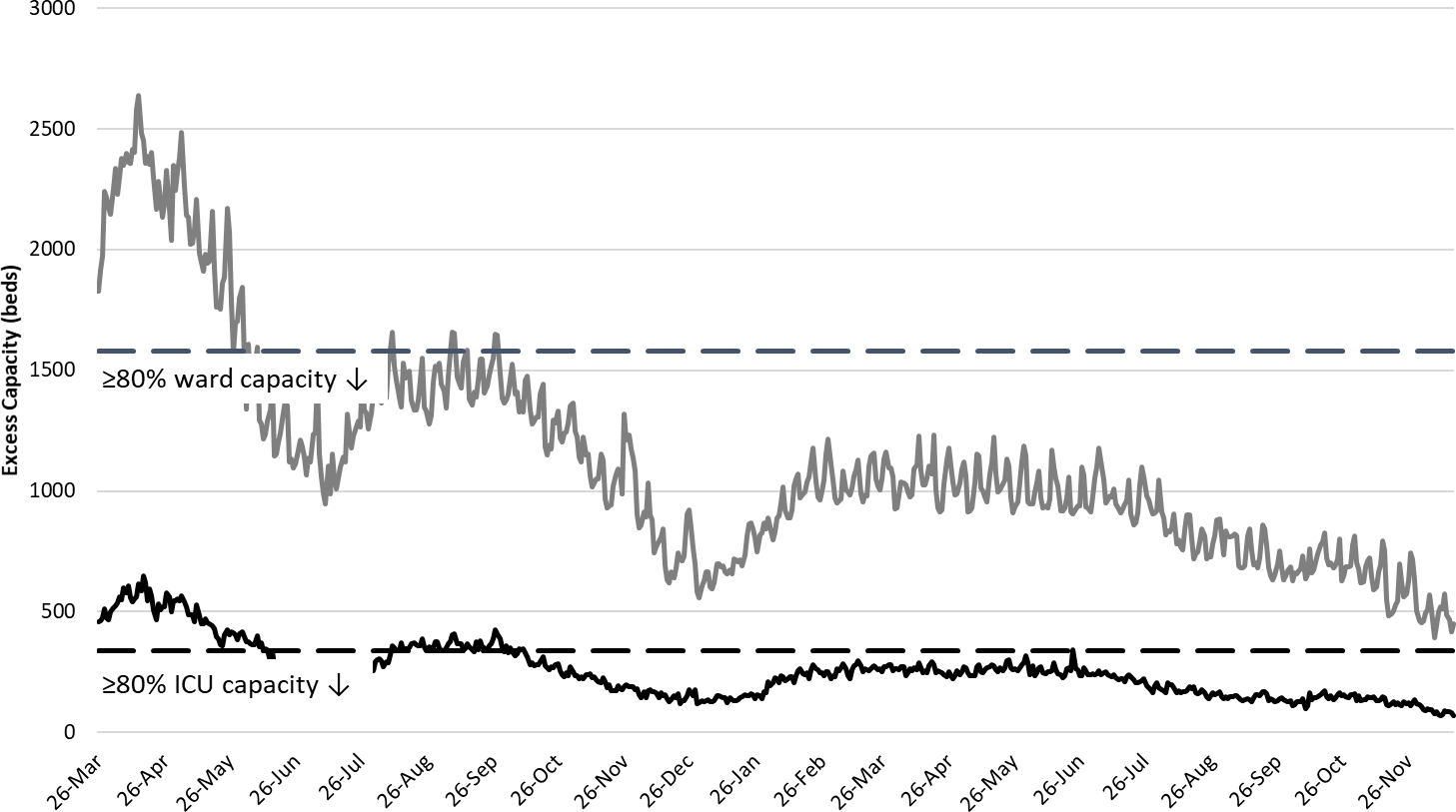
|
Figure 6. Observed Excess Non-Surge General Ward and ICU Capacity in Arizona March 26, 2020 – Dec 17, 2021. |
Arizona has been experiencing >300 COVID-19 deaths per week since the week ending November 14th (Figure 7). It is probable, that the week ending November 29th will exceed 400 deaths as it has already seen 394 deaths to date. At least 23487 Arizonans have lost their lives to COVID-19. However, as an updated mortality report from the Arizona Public Health Association indicates, excess deaths are considerably higher than the official COVID-19 death statistics. Therefore, considerably more Arizonans have lost their lives to COVID-19 than reflected by the ADHS Dashboard.
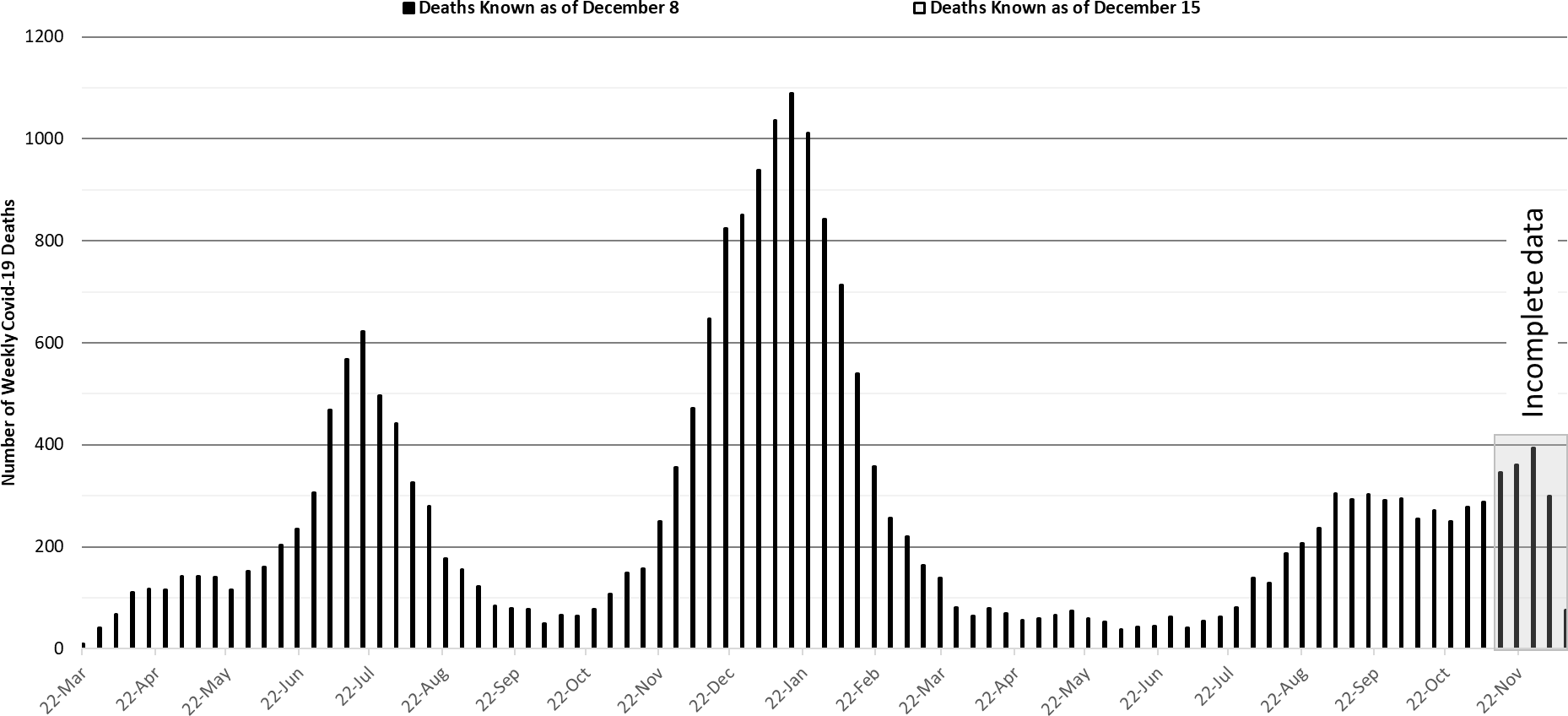
|
Figure 7. Weekly Arizona COVID-19 Deaths March 16, 2020 – December 12, 2021. |
Seasonal influenza cases in Arizona (blue line) remain below the 5-year historical average (Figure 8, grey bars) but rates at or below historical averages could still cause a feared ‘twindemic’ in late December – early January. Given current levels of hospital crowding, even a below-average year could still tip the balance such that extreme overcrowding occurs. This trend bears close observation over the next 4 – 8 weeks.
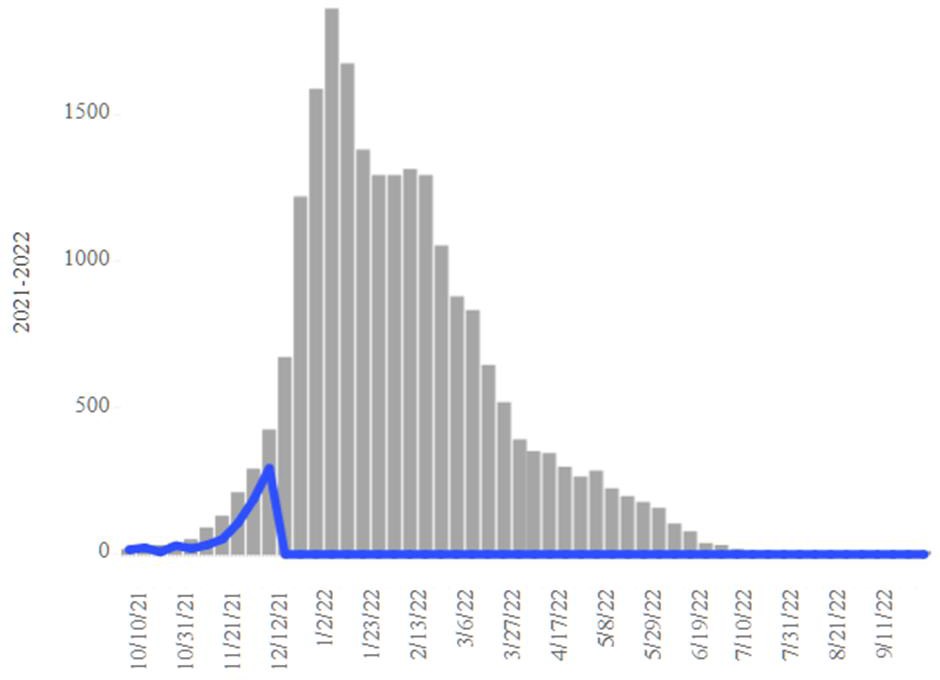
|
Figure 8. Arizona Influenza Cases in 2021 (blue) versus 5-Year Historical Average (grey). |
Pima County Outlook
For the week ending December 12th, 3002 Pima County residents were diagnosed with COVID-19, a 20% decrease from the initial tally of 3760 cases last week (Figure 9).
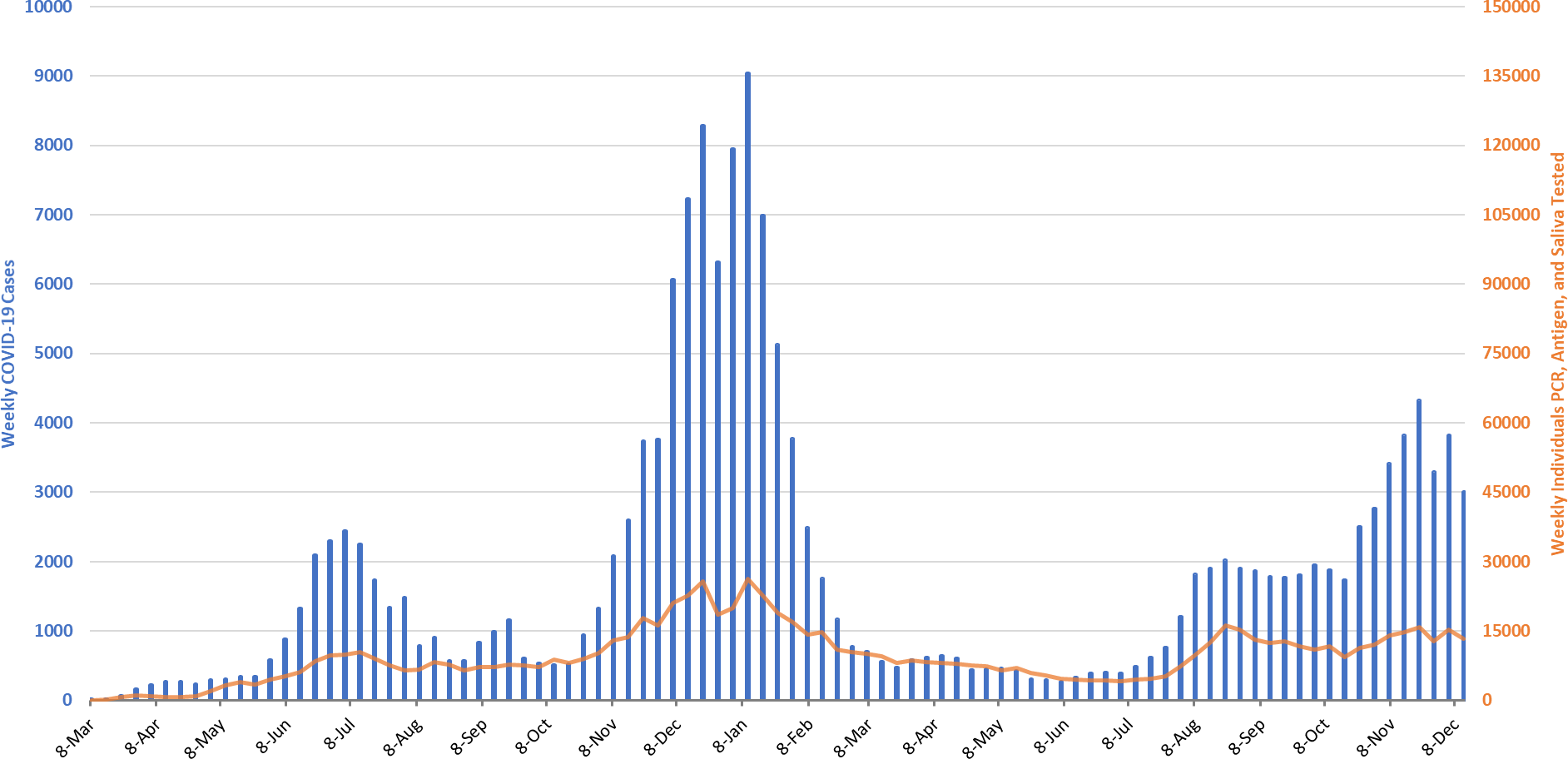
|
Figure 9. Weekly COVID-19 Cases in Pima County and Number of Individuals Undergoing COVID-19 Diagnostic Testing March 1, 2020 – December 12, 2021. |
Trends across the various age groups in Figure 10 below show generally lower transmission locally.
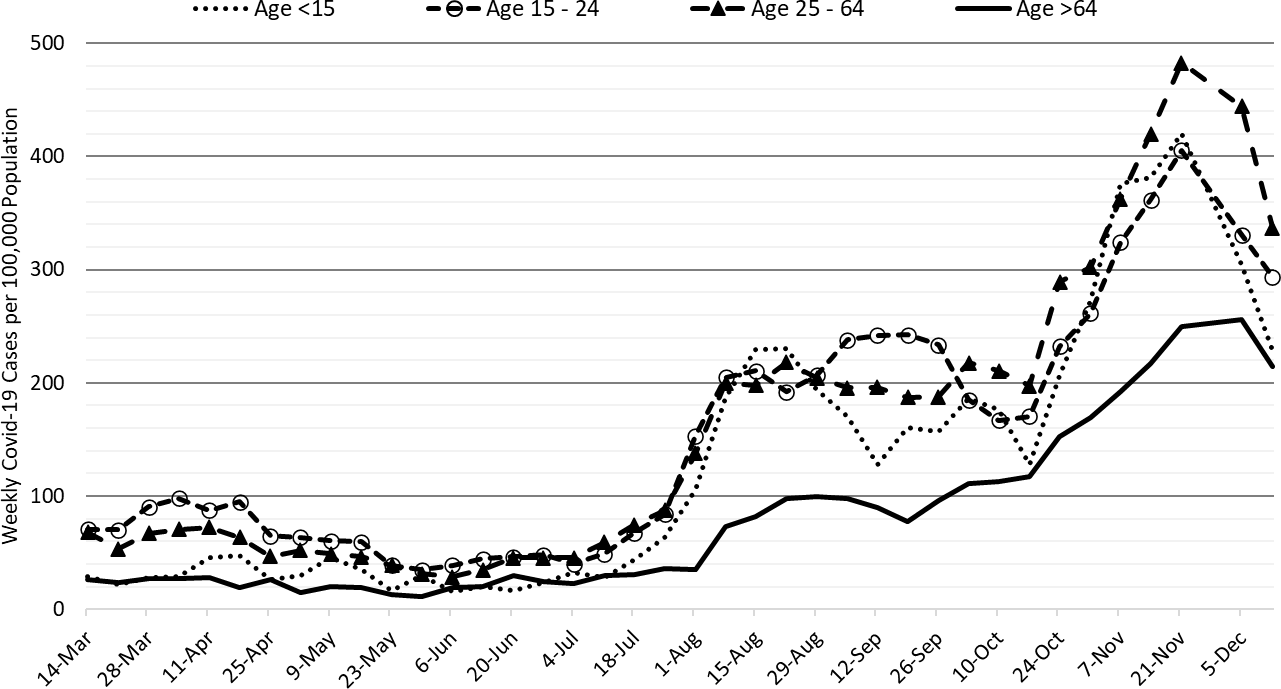
|
Figure 10. COVID-19 Cases in Pima County by Age Group March 7, 2020 – December 12, 2021. (Data from week ending November 28 are suppressed) |
Summary
- Arizona continues to experience high levels of community transmission attributable to the Delta variant.Test positivity remains high reminding us that test capacity, accessibility, and/or uptake is inadequate.Major behavioral shifts, waning immunity, and the newly emergent Omicron variant continues to pose risks of future increases in cases and hospitalizations in the coming weeks even though transmission is slowing as we head into the Christmas holidays. This is almost certainly a temporary reprieve given how quickly the Omicron variant has impacted the United Kingdom and western Europe.
- As of December 12th, new cases were being diagnosed at a rate of 336 cases per 100K residents per week.
- Mask mandates are needed at municipal and county levels to reduce transmission and relieve overwhelmed hospitals. Masking reduces viral transmission via aerosolized particles. Regardless of public action, individuals should mask in indoor settings using a KN-95 or better.
- Vaccination remains the most important medium-term public health priority to reduce transmission and severe illness.
- Waning vaccine immunity makes it imperative that all adults who were previously vaccinated obtain a booster, particularly those 50+ years of age.
- Third shot boosters provided additional protection against breakthrough infection https://jamanetwork.com/journals/jamainternalmedicine/fullarticle/2786890
- Third shot boosters may also provide additional protection against symptomatic breakthrough illness from Omicron (Page 20 – 21, UK Technical Briefing 31 https://assets.publishing.service.gov.uk/government/uploads/system/uploads/attachment_data/file/1040076/Technical_Briefing_31.pdf
- Risk factors for breakthrough hospitalization and death were recently elucidated in the British Medical Journal: Down’s syndrome, kidney transplantation, sickle cell disease, nursing home residents, chemotherapy, recent bone marrow or solid organ transplantation (ever), HIV/AIDS, dementia, Parkinson’s disease, neurological conditions, and liver cirrhosis. https://www.bmj.com/content/374/bmj.n2244
- ADHS and county health departments should re-open mass vaccination pods for boosters given low uptake among high-risk groups. There is a narrow window of opportunity over the next 2 - 4 weeks to prepare for the coming Omicron wave.
- Waning vaccine immunity makes it imperative that all adults who were previously vaccinated obtain a booster, particularly those 50+ years of age.
- The World Health Organization has named another COVID-19 variant of concern (VOC), the Omicronvariant.https://www.who.int/news/item/26-11-2021-classification-of-omicron-(b.1.1.529)-sars-cov-2-variant-of-concern
- The United Kingdom published a good overview of Omicron’s impact so far (Dec 17): https://assets.publishing.service.gov.uk/government/uploads/system/uploads/attachment_data/file/1042046/Technical_Briefing_32.pdf
- A pre-print (not peer-reviewed) examines various Omicron scenarios in the UK. Most models predict another large case wave beginning late December with peaks exceeding those of last year. Hospitalizations and deaths are expected to be lower than last year under many, but not all scenarios. While preliminary, it behooves us to act sooner rather than later. https://cmmid.github.io/topics/covid19/reports/omicron_england/report_11_dec_2021.pdf
- For those wanting to track variant data, here are links to genomic state data (https://pathogen.tgen.org/covidseq-tracker/) and national data (https://covid.cdc.gov/covid-data-tracker/#variant-proportions). Other surveillance methods include S-gene Target Failure (SGTF) from PCR testing and wastewater surveillance. Unfortunately, I do not have any links to publicly available data for these latter two mechanisms.
- COVID-19 hospital occupancy is now holding steady or declining but will exceed 25% of all beds in the general ward and 35% of beds in the ICU for the remainder of the year. Access to care will continue to be restricted in the face of staff shortages in inpatient and outpatient settings.
- January is poised to be a very difficult months for Arizona hospitals as three events will collide: (1) the tail of the Delta wave, (2), below average but still meaningful seasonal influenza, and (3) the Omicron wave. Given how poorly prepared we are, it is going to be ugly.
- Weekly COVID-19 deaths have now reached 300 per week and should remain at or above this level as long as cases exceed 20000 per week.So far, 23487 Arizonans have lost their lives to COVID-19.
- As an updated mortality report from the Arizona Public Health Association indicates, excess deaths are considerably higher than the official COVID-19 death statistics. Therefore, considerably more Arizonans have lost their lives to COVID-19 than reflected by the ADHS Dashboard.
- ADHS released its first report of COVID-19 cases and deaths by vaccination status. Consistent with data from other geographic regions, case rates are 4X higher and death rates are 15X higher in the unvaccinated than the vaccinated.
https://www.azdhs.gov/covid19/documents/data/rates-of-cov-19-by-vaccination.pdf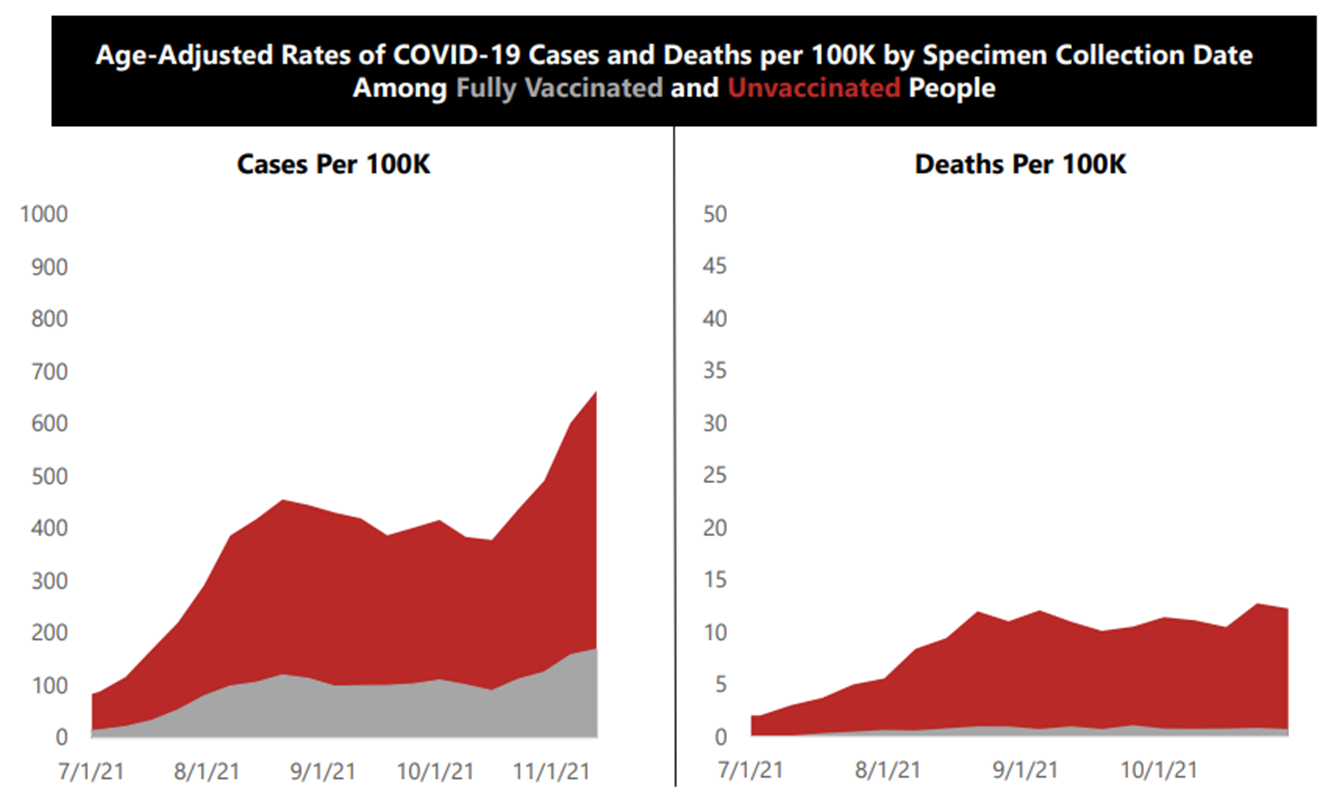
Forecast reports to date, available as PDFs
Download PDF to view additional charts of Arizona counties, available in appendix of report.
2020 Reports
Based on what we know now about this pandemic, we support guidelines for social distancing to slow the spread of the virus and urge everyone to follow the recommendations provided by the Centers for Disease Control and Prevention (CDC) to protect yourself, your family, your neighbors, and your employees. Please heed the recommendations as provided by the CDC.
COVID covid coronavirus virus covid19 corona forecast model







